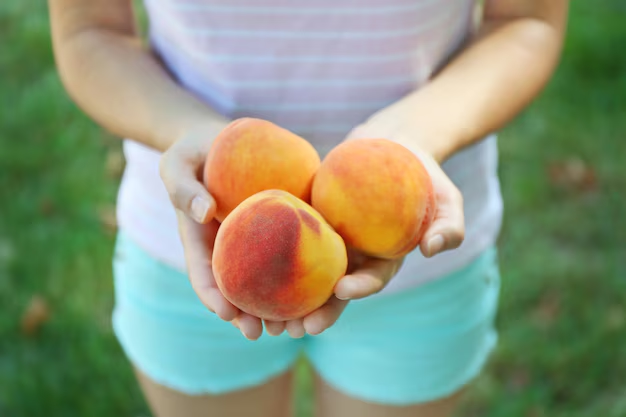Unlocking the Sweetness: Are Peaches a Good Choice for Diabetics?
Sweet, juicy, and deliciously refreshing, peaches are among the fruits that effortlessly capture the essence of summer. Whether you're biting into a fresh peach or savoring a warm peach cobbler, the experience is always delightful. But if you're living with diabetes, you might ask yourself: Are peaches safe for my diet? Can I enjoy these fruits without impacting my health negatively? Let's dive into these questions and explore the royal world of peaches.
🍑 Understanding Diabetes and Diet
Before we delve into the specifics of peaches, it’s important to understand the basics of diabetes and diet. Diabetes, a chronic metabolic condition, essentially revolves around the body's ability to process sugar. Regulating blood sugar levels is crucial, and a proper diet can significantly impact how diabetes is managed.
Key dietary considerations for diabetes:
- Glycemic Index (GI): Foods with a low GI are preferred as they cause a slower rise in blood sugar levels.
- Carbohydrate Counting: Keeping track of the number of carbs consumed is important since carbohydrates impact blood sugar the most.
- Balance and Moderation: A balanced diet that includes a variety of foods is beneficial.
🍑 Peaches and Their Nutritional Profile
Peaches are not only a treat for your taste buds but also pack a punch of nutritional goodness without tipping the scales in the wrong direction. Let's examine the nutritional content of peaches and how that relates to a diabetes-friendly diet.
Nutritional highlights of peaches (per medium-sized peach):
- Calories: Low in calories, making them a guilt-free snack.
- Carbohydrates: Peaches contain carbohydrates, but in moderation, they're unlikely to cause a spike in blood sugar.
- Fiber: Rich in dietary fiber, which supports digestion and can help manage blood sugar levels.
- Vitamins and Minerals: Bursting with vitamin C and other essential nutrients like potassium.
The modest carbohydrate content and the presence of dietary fiber make peaches a favorable fruit option for many individuals managing diabetes.
🍑 The Glycemic Index of Peaches
The Glycemic Index (GI) is a fundamental concept in determining how carbohydrate-containing food impacts blood glucose levels. Foods are scored on a scale from 0 to 100 based on how much they increase blood sugar levels after consumption.
Peaches on the Glycemic Index:
- GI Score: Peaches generally have a low to moderate GI rating, meaning they have a relatively minor impact on blood sugar levels compared to high-GI foods like white bread.
This lower GI score means that peaches release glucose more slowly and steadily. This can be particularly beneficial for diabetics aiming to maintain stable blood sugar levels.
🍑 Peaches: A Part of a Balanced, Diabetic-Inclusive Diet
So how can peaches fit into a balanced diet, especially for individuals managing diabetes? Here are practical ways to include peaches in your daily meal plan without compromising your health goals.
Fresh and Whole
Benefits: Eating fresh, whole peaches ensures you receive all the natural fiber and nutrients without unnecessary added sugars.
Tips:
- Keep the peel on for maximum fiber.
- Pair with a source of protein for a balanced snack.
Peaches in Salads
Benefits: Adding peach slices to salads can provide a burst of sweetness and nutrition.
Tips:
- Combine with leafy greens, nuts, and a protein source for a full meal.
- Drizzle with a vinaigrette that contains healthy fats for enhanced nutrient absorption.
Smoothies with Peaches
Benefits: A peach-based smoothie can be a refreshing and nutritious meal option.
Tips:
- Use unsweetened almond milk or another low-sugar milk alternative.
- Add leafy greens like spinach to boost fiber and nutrient content.
Peaches in Cooking and Baking
Benefits: Cooking with peaches can enhance the flavors of your dishes.
Tips:
- Use peaches to naturally sweeten sauces or desserts instead of refined sugars.
- Opt for recipes that use whole grain flours and low-glycemic ingredients.
🍑 Key Takeaways for Including Peaches in a Diabetic Diet
Summarized Guide:
- 🍑 Moderation is Key: Enjoy peaches in moderation as part of a balanced diet.
- 🥗 Smart Combinations: Pair peaches with foods that contain protein and healthy fats to stabilize blood sugar.
- 📏 Portion Control: Keep track of serving sizes to avoid excessive carbohydrate intake.
- 🏷️ Mind the GI: Include low-GI foods like peaches in your diet to help manage blood sugar levels.
- 🧑🍳 Cooking Tips: Use peaches as a natural sweetener in recipes to reduce the need for additional sugars.
Peaches, when consumed mindfully, can certainly be a part of a healthy diabetic diet. While enjoying this luscious fruit, it’s crucial to be aware of your overall carbohydrate intake and maintain balanced blood sugar levels.
🍑 Possible Alternatives and Considerations
While peaches are a great option, sometimes exploring alternatives or variations can be valuable:
- Canned Peaches: Opt for versions packed in water or natural juice, steering clear of those in heavy syrup.
- Peach Juice: Fresh peach juice can be appealing, but be cautious of portion sizes due to the concentrated sugar.
- Frozen Peaches: A convenient option when peaches are out of season, making sure no added sugars are present.
🍑 Enhancing the Diabetic Diet
Incorporating peaches into your meals is just one piece of the puzzle. A comprehensive approach to diet and lifestyle can further enhance your diabetes management:
- Regular Exercise: Consistent physical activity can aid in maintaining healthy blood sugar levels.
- Hydration: Stay well-hydrated as it supports overall metabolic functions.
- Consistent Meal Times: Regular eating schedules help in stabilizing blood sugar throughout the day.
In the exploration of whether peaches are good for diabetics, it emerges that they are indeed a nutritious and delightful addition to the diet when consumed with mindful attention to moderation and balance. So, relishing a peach or two as part of your meal plan might just be your sweet spot to maintaining health and happiness. Enjoy the sweetness of peaches without losing sight of your health goals. 🍑
